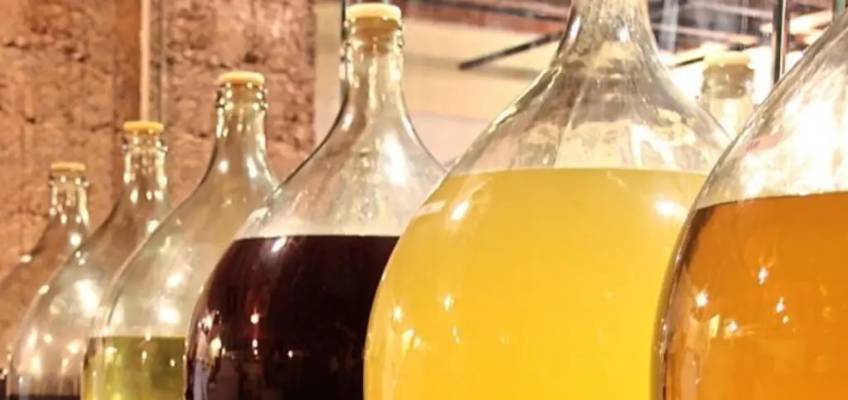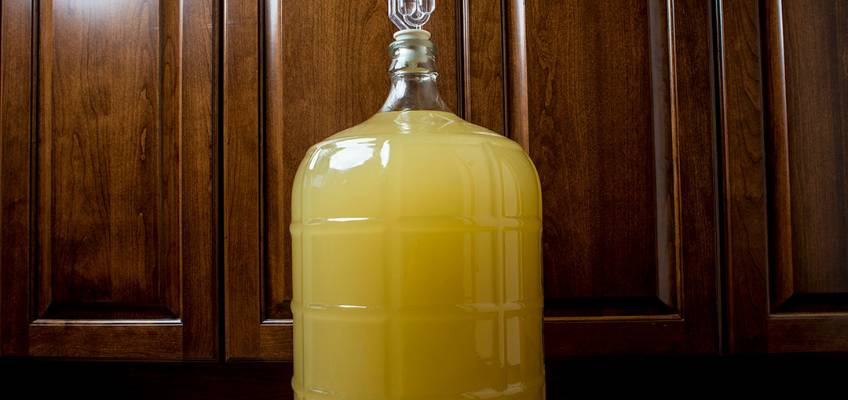
Easiest 1 Gallon Mead Recipe
Ever thought about brewing your own mead but felt intimidated by the process? You’re not alone – many beginners avoid making homemade mead because it seems complex. Fret no more! This blog post will introduce you to the easiest 1-gallon mead recipe, taking you on a foolproof journey from gathering ingredients to savoring your own honey wine.
Ready for an exciting, Viking-worthy adventure in home-brewing? Let’s dive into sweetness with confidence.
Key Takeaways
- The easiest 1 – gallon mead recipe only requires a few basic ingredients and equipment.
- To make this recipe, you will need honey, water, yeast, and yeast nutrient.
- Follow the step-by-step instructions carefully to create your homemade mead.
- Age your mead for at least three months to allow the flavors to develop and mellow.
Want to taste professionally brewed mead? Click here to check out our delicious top sellers.
The Basics of Making Mead
Mead is a fermented beverage made from honey, water, and yeast, often referred to as “honey wine.”
What is Mead?
Mead, often referred to as honey wine, is a traditional fermented beverage that’s been savored by mankind for ages. It’s made from just three primary ingredients – honey, water, and yeast.
Considered an alcoholic delight of the Vikings sailing through Scandinavia, this drink comes in a broad variety of flavors and variations. This incredibly versatile beverage ranges from sweet to dry or even sparkling depending on the brewing techniques employed.
Its rich history and enchanting flavor profile make it one of the oldest known delights enjoyed globally today!
The Easiest 1 Gallon Mead Recipe
To make the easiest 1 gallon mead, you will need a few key pieces of equipment and basic ingredients.
Equipment List
Let’s gather the necessary equipment for preparing mead at home. The success of your homemade mead can hugely depend on having the right tools. Here’s what you need:
- A one-gallon jug: This is where all the magic happens.
- Airlock and stopper: These tools are essential to keep air out while letting gases escape during fermentation.
- Long spoon or stir stick: You’ll need this to mix your ingredients together.
- Measuring cup: For accurate measurements, a measuring cup comes in handy.
- Siphon tubing: Necessary for transferring your brew without disturbing the sediment.
- Sanitizer: Cleanliness is integral in brewing; sanitizer keeps all your equipment bacteria-free.
- Thermometer: It helps monitor temperature during different stages of brewing.
- Hydrometer: This device allows you to measure the alcohol content by checking the specific gravity before and after fermentation.
Ingredients Needed
To make this easy one gallon mead recipe, you will need the following ingredients:
- Honey: You’ll need 2-3 pounds of honey to give your mead its sweet and flavorful taste.
- Water: Use 1 gallon of clean, filtered water for the base of your mead.
- Yeast: Choose a wine yeast that is suitable for mead making. This will help with fermentation.
- Yeast Nutrient: Adding yeast nutrient helps to provide essential nutrients for the yeast during fermentation.
- (Optional) Berries or fruit of any kind fresh
Step-by-Step Instructions
Making your own mead is easier than you think! With just a few simple steps, you can create a delicious batch of this ancient fermented beverage. Here’s how:
Step-by-Step Guide to Home Brewing Mead
Step 1: Sterilize Your Brewing Gear
Before starting, ensure all equipment that will come in contact with your brew is thoroughly sanitized.
Step 2: Prepare the Honey-Water Mixture
Heat approximately half a gallon of non-chlorinated water in a pot over medium heat. When it’s warm—but not boiling—stir in the honey until it fully dissolves. Then, turn off the heat.
Step 3: Add Fruits and Flavor Enhancers
Place your choice of berries or other fruits, orange slices (including the skin), and raisins into your one-gallon jug.
Step 4: Transfer the Honey-Water Mix
Using a funnel, carefully pour your honey-water solution into the jug containing the fruits.
Step 5: Complete the Must
Top off the jug with cold, preferably filtered, water. Be sure to leave at least two inches of space at the top. Seal the jug with its lid and gently swirl the contents to mix.
Step 6: Introduce the Yeast
Ensure that the must (unfermented mead) is below 90°F. Sprinkle in half a packet of champagne yeast. Tighten the lid and give the jug a good shake for a minute or two to evenly distribute the yeast.
Step 7: Set Up the Airlock
Fill the airlock with water up to the indicated line. Insert the rubber stopper end into the jug’s opening.
Step 8: Let the Magic Happen
Place the jug in a dark, undisturbed location. Fermentation should begin within 12 to 24 hours, evidenced by bubbling in the airlock.
Step 9: Time to Bottle
After 4 to 6 weeks of fermentation, when you notice no more bubbles rising, your mead is ready to be bottled and aged.
Tips and Additional Information
Age your mead for at least three months to allow the flavors to develop and mellow. Transferring your mead to a secondary fermentor is optional, but it can help clarify the final product.
Don’t forget to add yeast nutrient during fermentation for a healthier and more active fermentation process. Experiment with different fruits, herbs, or spices to create unique flavor profiles in your homemade mead.
Enjoy the satisfaction of sipping on your very own batch of delicious mead!
How long should I age mead?
Aging mead is an important step in the process to develop its flavors and smoothness. The length of time you should age your mead depends on personal preference and the style of mead you are making.
Generally, it is recommended to age meads for at least 6 months to a year before enjoying them. This allows the flavors to mellow and blend together, resulting in a more refined taste.
However, some meads may benefit from even longer aging periods, especially if they have higher alcohol content or complex flavor profiles. So, be patient and let your mead mature to perfection before savoring its deliciousness!
Should I transfer mead to a secondary fermentor?
Transferring mead to a secondary fermentor is an optional step in the mead-making process. Some brewers choose to do this to clarify their mead or for bulk aging purposes. By transferring the mead into a secondary vessel, you can leave behind any sediment that may have settled during primary fermentation, resulting in a clearer final product.
It also allows the flavors of your mead to develop further as it ages. However, keep in mind that transferring can introduce oxygen into the mead, which may impact its flavor profile.
Ultimately, whether or not to transfer your mead will depend on personal preference and desired outcomes for your homemade creation.
Other tips for brewing mead
Here are some additional tips to help you with your mead brewing journey:
- Experiment with different flavors: Don’t be afraid to get creative and try out various fruit, spice, or herb combinations to add unique flavors to your mead.
- Use high-quality honey: The quality of honey greatly affects the taste of your finished mead, so opt for raw or local honey for the best results.
- Maintain proper fermentation temperature: Keep an eye on the temperature during fermentation as it can impact the flavor and aroma of your mead. Aim for a consistent temperature between 65-75°F (18-24°C).
- Be patient with aging: While your mead may be drinkable after a few weeks, allowing it to age for several months can greatly improve its flavor complexity and smoothness.
- Practice good sanitation: Ensure that all your equipment is thoroughly cleaned and sanitized before starting each batch of mead to prevent any unwanted bacterial or yeast growth.
- Monitor the fermentation process: Use a hydrometer to track the specific gravity readings throughout fermentation. This will help you determine when fermentation has completed and ensure that your mead has reached its desired sweetness level.
- Consider using yeast nutrients: Adding yeast nutrients during fermentation can provide essential nutrients for healthy yeast activity, resulting in a more vigorous fermentation and better-tasting mead.
Enjoying your homemade mead
Raise your glass and savor the sweet taste of victory as you enjoy your very own homemade mead. Whether you prefer a traditional honey wine or want to experiment with unique flavors like lemon balm or grape, the possibilities are endless.
Sit back, relax, and let the rich history of this ancient beverage transport you to a time when Vikings sailed through Scandinavia with horned mugs in hand. With just a few simple ingredients and easy-to-follow instructions, making mead has never been more accessible.
So gather your friends, uncork a bottle of your finished creation, and toast to your newfound skills as a master meadmaker. Cheers!
Conclusion
Making your own mead doesn’t have to be complicated. With this easy 1-gallon recipe, you can enjoy the delicious taste of homemade honey wine in no time. Just follow the step-by-step instructions, gather your equipment and ingredients, and soon you’ll be sipping on a glass of sweet, caramelized goodness.
Cheers to your brewing adventure!
FAQs
1. Is mead healthier than beer?
Mead, the ancient honey-based beverage, has been gaining popularity among beer enthusiasts. But is it healthier than beer? While both mead and beer contain alcohol, mead offers some potential health benefits.
It is often made with natural ingredients like honey and water, which can provide antioxidants and anti-inflammatory properties. Additionally, mead contains no gluten, making it a suitable option for those with gluten sensitivities or celiac disease.
However, moderation is key when consuming any alcoholic beverage for optimal health benefits. So if you’re looking to switch things up from beer, mead might be a tasty and potentially healthier alternative worth exploring.
2. How long does honey mead take to ferment?
The fermentation process for honey mead typically takes around 2 to 6 weeks. During this time, the yeast consumes the sugars in the honey and produces alcohol. The length of fermentation can vary depending on factors such as temperature, yeast used, and recipe variations.
It’s important to monitor the progress by taking gravity readings using a hydrometer until the desired final gravity is reached. Once fermentation is complete, you can proceed with bottling and aging your homemade mead for even better flavor development.
3. Is raw honey okay for mead?
Raw honey is absolutely fine for making mead! In fact, it’s one of the key ingredients in this delicious beverage. Raw honey adds a unique flavor profile to your mead and provides natural sugars that will be fermented by the yeast during the brewing process.
So go ahead and use raw honey to create your homemade mead – it will result in a flavorful and authentic drink that you can enjoy with friends or family.
4. How much active yeast for 1 gallon of mead?
To make one gallon of mead, you will need one packet or about 5 grams of active yeast. This will help kickstart the fermentation process and turn your honey and water mixture into delicious mead.
Make sure to choose a yeast strain that is suitable for mead making, such as wine yeast. It’s important to use the right amount of yeast to ensure proper fermentation and avoid any issues with the final product.
So grab your packet of active yeast and get ready to brew up some tasty homemade mead!
5. What is the easiest 1-gallon mead recipe?
The basic mead recipe, often considered the easiest, includes honey and water at a ratio that balances sweetness to make traditional sweet mead.
6. Can I add other flavors to my mead recipes?
Yes, you can. Fruit like grape or lemon balm, along with caramelized honey can enhance your sweet mead and introduce new flavor profiles in your homemade brews.
7. How do I make caramelized honey mead?
Caramelized honey mead involves heating the honey until it reaches a dark amber color before mixing with water; this creates a unique richness in flavor for your one gallon of concoction.
8. Are there variations of fruit-based traditional one-gallon recipes?
Sure! Incorporating fruits like grapes or adding herbs such as lemon balm are common variations seen in traditional fruit-meal recipes.

Exploring the Mystical Brew: Mead in Norse Mythology
Mead Tasting 101: What You Need to Know About Honey Wine


